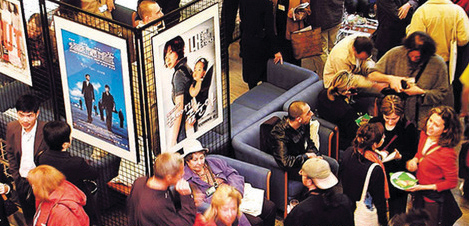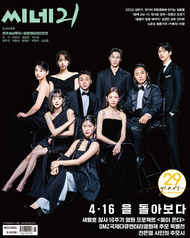어렸을 때부터 나는 평론가들이 칸영화제를 시네필들의 메카처럼 얘기하는 걸 들었다. 그들 말을 들으면 그저 하루 종일 영화 보고 그 다음에 카페 가서 영화예술에 대한 길고 열정적인 토론을 하는 것으로만 이루어진 것이었다. 칸영화제에 대해 갖고 있었다면 갖고 있었던 환상은 지난해 처음 참가하면서 깨졌다. 물론 위상 덕택에 칸이 중요한 영화를 여러 편 개봉하는 것은 사실이지만, 크로아제트 거리를 한번 빠르게 걸어 내려가기만 해도 충분히 알 수 있는 것은 스포츠 차, 비즈니스 거래 그리고 할리우드 스타들이 무대 중앙을 차지하고 있으며, 시네필들은 한구석에 옹기종기 모여 시끄러움 속에서 집중하려고 노력한다는 것이다.
그렇다면 진지한 시네필들이 그런 큰소리의 마케팅 없이 영화를 체험하려면 갈 수 있는 곳이 어디인가? 어쩌면 세계 각지에서 온 혁신적인 영화에 전념하기로 오랫동안 알려진 로테르담영화제일지도 모른다. 그렇지만 요즘 영화애호의 성격 자체가- 적어도 좀더 젊은 세대에서는- 바뀌어가고 있는 것 같다. 한국영화 프로그램 자문으로 일하는 이탈리아의 우디네영화제에 해마다 가는데, 지난주에 그곳에 있는 동안 새로운 별종의 영화애호가 형성되고 있는 것을 감지할 수 있었다.
건방지게 우스꽝스러운 일본 잠수함 드라마 <로렐라이>나 감독 본인이 ‘정말 나쁜’ 영화라 묘사한 필리핀 섹스코미디 <미스터 스와브> 같은 작품을 상영하는 행사에 ‘시네필’이라는 딱지를 붙여주는 것이 이상할 수도 있다. 그렇지만 daily.greencine.com같이- 요즘 영화애호가들이 무슨 글을 쓰는지 계속 알고 지내기에 좋은 방법 중 하나인- 웹블로그를 읽어보면 젊은 평론가들이 “예술을 위한 예술”의 개념에서 훨씬 벗어나 시야를 넓혔다는 것을 깨닫게 된다. 400달러짜리 명품 셔츠를 싸구려 청바지에 맞춰 입을 십대들처럼 오늘날의 영화애호가들은- 문화적, 역사적, 양식적 또는 정치적인 것같이- 넓은 범위의 분석적 접근을 이용하여 관조적인 예술영화관용 작품부터 열광적으로 폭력적인 슬래셔영화를 아우르는 영화들을 논한다.
우디네영화제가 어떤 면으로는 젊은 시네필들에게 이상적으로 어울린다. <로렐라이>는 많은 사람의 심장을 두근거리게 할 일은 없겠지만, 일본 대중의 상상 속에 2차 세계대전의 기억이 어떻게 그려지는지 보여주는 신기한 일을 해주기는 한다. 아시아 내에 있는 영화제들은 주최국 영화쪽에 기우는 경향이 있는 반면, 이탈리아라는 “중립적인” 위치는 각국의 영화가 동등한 자격으로 소개될 수 있게 해준다. 아시아 국가들에서 온 영화를 보면서 각국 영화산업의 강약점과 특징을 훨씬 깊게 이해할 수 있게 된다.
이 영화제의 또 다른 면들도 시네필들에게 어울리는 분위기를 제공해준다. 대부분의 상영회는 1200석 단관에서 이루어지는데, 모두가 영화를 같이 보고 끝난 뒤 함께 토의한다. 그래서 동시에 여러 가지 다른 영화를 한꺼번에 상영하는 좀더 큰 영화제하고는 굉장히 다른 느낌을 주는 것이다. 이 영화제는 또한 해마다 300명에 이르는 영화학생들에게 숙소를 제공하여 젊고 열광적인 관객을 구성케 한다. 마지막으로, 이탈리아 문화는 영화애호가에게 쓸모있는 두 가지 것을 제공해주는데, 그것은 상영회 동안에 사람들을 깨어 있게 하는 다량의 진한 커피와 밤이 깊도록 사람들이 계속 이야기할 수 있도록 해주는 싸지만 좋은 와인이다.
요즘 일반적으로 젊은 세대 영화평론가라면 인터넷에 (흔히 무료로) 글을 쓰며, 이 활동을 다른 분야에 풀타임 직장과 절충하고 있다. 이런 평론가는 업계에 거점을 둔 기성 평론가들에 비해 보통 일년에 영화제 한두 군데밖에 참가하지 못한다. 그럼에도 현대 세계영화에 대한 토의를 점점 주도하고 있는 것은 이러한 젊은 시네필들이다. 그리고 점차적으로 이들 평론가들은 칸영화제의 대혼란을 헤매기보다 우디네영화제와 같이 상대적으로 작은 영화제들에 참가하고 있다.
From the time I was young, I've heard critics talk about Cannes as a kind of mecca for cinephiles. From their words, it seemed to consist of nothing more than watching movies all day long, followed by a trip to the cafe for long, passionate discussions about the art of cinema. Any illusions I may have had about the festival were shattered last year when I actually attended for the first time. Although, thanks to its status, Cannes certainly does premiere a large number of important films, a quick walk down the Croisette is enough to see that the sports cars, business deals, and Hollywood stars take center stage, while the cinephiles huddle off in a far corner, trying to concentrate amidst all the noise.
So where can a committed cinephile go these days to experience film without the loud marketing? Perhaps at an event like Rotterdam, which has long been known for its commitment to innovative filmmaking from throughout the world. Yet these days the very nature of cinephilia also seems to be changing, at least among younger generations. Last week, during my annual trip to the Far East Film Festival in Udine, Italy, where I work as the Korea programme consultant, it seemed that I could detect a new, different kind of cinephilia starting to take shape.
It may seem odd to label an event as "cinephile" when it screens works like the obnoxiously silly Japanese submarine drama Lorelei or the Philippine sex comedy Mr. Suave ? which its own director described as a "really bad" movie. But if you read through weblogs like daily.greencine.com -- one of the best ways to keep track of what today's cinephiles are writing about -- you realize that younger critics have widened their gaze far beyond the idea of "art for art's sake." Like teenagers who will mix a $400 designer shirt together with a cheap pair of jeans, today's cinephiles take on a wide range of analytical approaches ? cultural, historic, stylistic, or political ? to discuss works ranging from contemplative arthouse fare to hyper-violent slasher films.
The festival in Udine is in some ways an ideal fit for young cinephiles. Lorelei is unlikely to set many hearts racing, but it does provide a fascinating look at how the memory of World War II is portrayed in the popular Japanese imagination. Whereas festivals within Asia itself tend to be skewed towards their host country, the "neutral" location of Italy allows films from each country to be presented on an equal footing. Seeing films from all Asian countries screened together, one gains a much deeper understanding of each film industry's strengths, weaknesses, and particular characteristics.
Other aspects of the festival give it an atmosphere well suited to cinephiles. The vast majority of screenings are held in a single 1200-seat theater, so everyone watches films together and discusses them afterwards. This gives the event a much different feel from bigger festivals where many different films play at the same time. The festival also provides accommodation for up to 300 film students per year, making for a young and enthusiastic crowd. Finally, Italian culture provides two things that are very useful to the cinephile: lots of strong coffee to keep people awake during screenings, and lots of cheap but very good wine to keep people talking long into the night.
These days, the typical young generation film critic writes mostly for the internet (often for free) and usually balances a full time job in another field. Such critics can usually only attend a couple film festivals per year, compared to established critics who have a foothold in the industry. Yet it is these younger cinephiles who are increasingly taking the lead in discussions about contemporary world cinema. And more and more, such critics are attending smaller festivals like Udine rather than navigating the chaos at Cannes.




